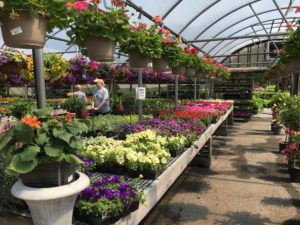Hello Fellow Readers,
(Excuse the late posting of this week’s column. I’ve been hobbling along without internet since last Tuesday’s Wizard of Oz storm. Humbling!)
We have the green light for annuals based on the wisdom to wait until after the last frost date, typically May 19th in our neck of the woods (zone 6 or 5b). The cultural considerations for plants sharing the same space in a garden or pot must be the same. Nurseries don’t always arrange their inventory accordingly so read labels for sun versus shade. And many nurseries sell perennials in flats as well. For those of you brave enough to ask what the difference between annuals and perennials is, here’s the skinny….
 Annuals live for one growing season rather than come up annually as perennials do, which can be confusing and opposite of what their words imply. One way to think of it is annuals bloom from spring until frost providing season-long color but must be replanted annually, hence the name. Some do self-seed such as Four o’clocks (Mirabilis jalapa), Tobacco Plants (Nicotiana), Floss Flower (Ageratum houstonianum) and Snapdragons (Antirrhinum) – all these self-seeders are deer resistant I might add. Just to add to the perplexity, what are annuals here may be perennials in hardier zones. Perennials tend to have a relatively short season of bloom, but by combining several species of perennials you can create a season full of color. And, because they come up every year, you can save money in the long run.
Annuals live for one growing season rather than come up annually as perennials do, which can be confusing and opposite of what their words imply. One way to think of it is annuals bloom from spring until frost providing season-long color but must be replanted annually, hence the name. Some do self-seed such as Four o’clocks (Mirabilis jalapa), Tobacco Plants (Nicotiana), Floss Flower (Ageratum houstonianum) and Snapdragons (Antirrhinum) – all these self-seeders are deer resistant I might add. Just to add to the perplexity, what are annuals here may be perennials in hardier zones. Perennials tend to have a relatively short season of bloom, but by combining several species of perennials you can create a season full of color. And, because they come up every year, you can save money in the long run.
Beware of the risks and perils of shopping for annuals: choosing on appearances alone, bringing home the uninvited, and selecting those that may be too mature. Rather than buying plants in full bloom, choose those that are yet to bloom or have only a few flower buds. That way the plant can put energy into developing a strong root system to produce all-season color, rather than a rush of bloom followed by a quick decline. In fact, removing flower buds is a technique to encourage root development.
Speaking of roots, look for fully developed roots without being root bound. No slipping them out of the pot though, unless the garden center invites you to. Assessing if an annual or perennial is rootbound is in the feel of the pot; kind of like choosing a cantaloupe. Feel its weight in relation to size then give a gentle squeeze to feel if the roots are too tight in the pot.
Look for plants that are full figured rather than tall and leggy. Yeah, baby! And stay clear of spotted, discolored, or holey foliage which may be evidence of disease or insects.
Don’t hesitate to mix perennials, annuals and even edibles such as tomatoes, peppers, and herbs into your flower gardens and pots. After all, veggies are beautiful as plants, in flower, and when in fruit so why not look beyond their edible function. Cutting gardens mixed with vegetables are called Kitchen Gardens also known as a Potager. Aren’t you trendy!
Garden Dilemmas? Askmarystone@gmail.com


